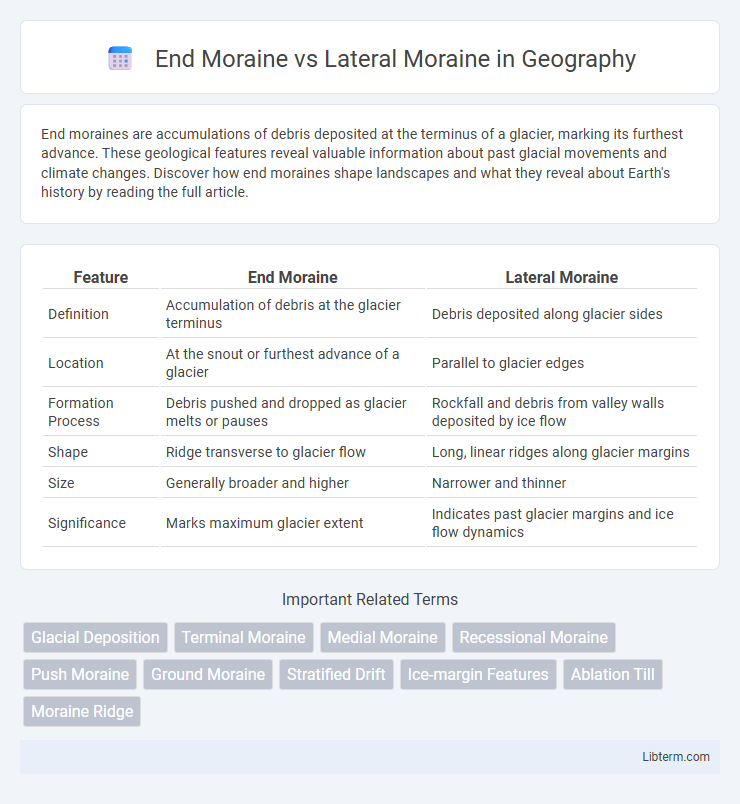End moraines are accumulations of debris deposited at the terminus of a glacier, marking its furthest advance. These geological features reveal valuable information about past glacial movements and climate changes. Discover how end moraines shape landscapes and what they reveal about Earth's history by reading the full article.
Table of Comparison
| Feature | End Moraine | Lateral Moraine |
|---|---|---|
| Definition | Accumulation of debris at the glacier terminus | Debris deposited along glacier sides |
| Location | At the snout or furthest advance of a glacier | Parallel to glacier edges |
| Formation Process | Debris pushed and dropped as glacier melts or pauses | Rockfall and debris from valley walls deposited by ice flow |
| Shape | Ridge transverse to glacier flow | Long, linear ridges along glacier margins |
| Size | Generally broader and higher | Narrower and thinner |
| Significance | Marks maximum glacier extent | Indicates past glacier margins and ice flow dynamics |
Introduction to Moraines
Moraines are accumulations of glacial debris formed by the movement and melting of glaciers, with end moraines marking the furthest advance of a glacier and lateral moraines deposited along its sides. End moraines consist primarily of unsorted till that creates ridges at the glacier's terminus, while lateral moraines are ridges of debris accumulated along the glacier's edges. Understanding these moraines helps reconstruct past glacial extents and landscape evolution in glaciated regions.
What is an End Moraine?
An end moraine is a ridge of debris deposited at the terminus of a glacier, marking its maximum advance and acting as a geological record of past glacial movement. Unlike lateral moraines, which form along the sides of glaciers from material falling off valley walls, end moraines accumulate directly in front of the glacier as it pushes forward. These formations provide critical insights into glacial dynamics, climate history, and landscape evolution.
What is a Lateral Moraine?
A lateral moraine is a ridge of debris deposited along the sides of a glacier, formed by the accumulation of rock and sediment that falls from the valley walls onto the glacier's edges. This type of moraine contrasts with an end moraine, which is deposited at the glacier's terminus, marking the furthest advance of the ice. Lateral moraines provide critical geological evidence of past glacier movement and help in reconstructing paleoclimate conditions.
Formation Processes of End Moraines
End moraines form from the accumulation of debris deposited at the snout of a glacier during its stationary or retreating phases, creating ridges that mark the glacier's maximum advance. This process involves the transportation of sediments by ice flow, which are released as the glacier melts, leading to a buildup of unsorted till at the glacier terminus. In contrast, lateral moraines develop along the edges of glaciers, formed by debris falling from valley walls onto the glacier surface and being pushed along the sides during ice movement.
Formation Processes of Lateral Moraines
Lateral moraines form along the sides of a glacier due to the accumulation of rock debris and sediment that falls from valley walls, which is transported and deposited as the glacier advances or retreats. These processes involve frost weathering and mass wasting from adjacent slopes, where material is carried parallel to the glacier flow, creating linear ridges. In contrast, end moraines are formed at the glacier's terminus from debris pushed or dropped as the glacier reaches its furthest extent.
Key Differences: End Moraine vs Lateral Moraine
End moraines form at the terminus of glaciers, indicating the furthest advance of ice and consisting of accumulated debris pushed forward by glacial movement. Lateral moraines develop along the sides of glaciers, composed primarily of rock and sediment deposited from the valley walls as the glacier erodes the landscape. The key difference lies in their location and formation process: end moraines mark the glacier's endpoint, while lateral moraines trace the glacier's edges.
Geological Significance of End Moraines
End moraines, formed at the terminus of a glacier, mark the maximum advance of the ice and serve as crucial indicators of past glacial extents and climatic conditions. These accumulations of debris provide valuable information for reconstructing glacial history and understanding sedimentary processes during glacial retreat. In contrast, lateral moraines run parallel to glacier edges and primarily record the glacier's width and marginal erosion rather than its advance or retreat.
Geological Importance of Lateral Moraines
Lateral moraines are significant geological features formed by the accumulation of debris along the sides of glaciers, providing critical evidence of past glacial extents and movements. These ridges composed of unsorted sediment help geologists reconstruct historical climate conditions and glacier dynamics, serving as natural markers for studying ice flow patterns and retreat phases. Unlike end moraines, which mark the glacier's terminus, lateral moraines are essential for understanding the lateral boundaries and stability of ancient ice masses.
Notable Examples Around the World
End moraines, formed at the terminus of glaciers, include notable examples such as the Long Island moraine system in the United States and the South Island terminal moraines in New Zealand. Lateral moraines, which develop along the sides of glaciers, are prominently observed in the Swiss Alps, particularly in the Aletsch Glacier, and the Glacier National Park in Montana, USA. Both types of moraines provide critical geological evidence of past glacial activity and are essential for studying Earth's climatic history.
Conclusion: Comparing End and Lateral Moraines
End moraines form at the snout of glaciers, marking the furthest advance with accumulated debris, while lateral moraines develop along glacier sides from material falling off valley walls. Both features indicate past glacier movement but differ in position and composition, with end moraines generally thicker and broader due to continuous debris accumulation. Understanding these distinctions aids in reconstructing glacial history and landscape evolution in glaciated regions.
End Moraine Infographic

 libterm.com
libterm.com